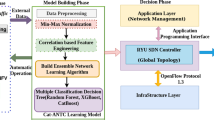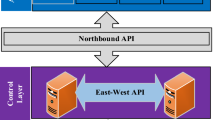Abstract
According to a study on advanced technology, resource planning, and design for Fifth Generation (5G) architecture and elsewhere, network traffic classification is a basic and complex part of software-defined networking (SDN). 5G requires end-to-end security that uses its software-defined architecture to automatically monitor the network and classify the traffic flows. To improve the security in network traffic classification, it is necessary to apply a correct set of policy rules to classify future network traffic flows. To create a communication-efficient and intelligent traffic classification framework in the SDN environment, machine learning is used between the data and the control planes. The proposed ensemble learning pre-processing tool to categorize incoming VPN traffic by applying a possible set of policies. The proposed technique is compared with existing classifiers and has a higher accuracy of 98% to 99.9% for ensemble models than single classifiers and other existing options, according to an evaluation of performance.








Similar content being viewed by others
Availability of data and materials
Data sharing is not applicable to this article as no datasets were generated or analyzed during the current study.
References
Foukas X, Patounas G, Elmokashfi A et al (2017) Network slicing in 5g: Survey and challenges. IEEE Commun Mag 55(5):94–100. https://doi.org/10.1109/MCOM.2017.1600951
Popovski P, Trillingsgaard KF, Simeone O et al (2018) 5g wireless network slicing for embb, urllc, and mmtc: a communication-theoretic view. IEEE Access 6:55,765-55,779
Kobbaey T, Hamzaoui R, Ahmad S et al (2021) Enhanced collision resolution and throughput analysis for the 802.11 distributed coordination function. Inter J Commun Syst 34(16):e4953
Afolabi I, Taleb T, Samdanis K et al (2018) Network slicing and softwarization: a survey on principles, enabling technologies, and solutions. IEEE Commun Survey Tutor 20(3):2429–2453
on 5G Architecture:5G PPP Architecture Working Group V (2014) 5g architecture. https://5g-ppp.eu/wp-content/uploads/2014/02/5G-PPP-5G-Architecture-WP-For-public-consultation.pdf/
Wang M, Cui Y, Wang X et al (2017) Machine learning for networking: Workflow, advances and opportunities. IEEE Network 32(2):92–99. https://doi.org/10.1109/MNET.2017.1700200
Nunes BAA, Mendonca M, Nguyen XN et al (2014) A survey of software-defined networking: Past, present, and future of programmable networks. IEEE Commun surveys Tutor 16(3):1617–1634. https://doi.org/10.1109/SURV.2014.012214.00180
Abbas K, Khan TA, Afaq M et al (2021) Network slice lifecycle management for 5g mobile networks: An intent-based networking approach. IEEE Access 9:80,128-80,146
Xie J, Yu FR, Huang T et al (2018) A survey of machine learning techniques applied to software defined networking (sdn): Research issues and challenges. IEEE Commun Surveys Tutor 21(1):393–430. https://doi.org/10.1109/comst.2018.2866942
Adedeji PA (2020) Hybrid Renewable Energy-Based Facility Location: A Geographical Information System (GIS) Integrated Multi-Criteria Decision-Making (MCDM) Approach. University of Johannesburg (South Africa)
Cisco (2021) Global traffic. https://www.cisco.com/
Dataset T (2016) Dataset details. https://www.unb.ca/cic/datasets/vpn.html
Rezaei S, Liu X (2018) How to achieve high classification accuracy with just a few labels: A semi-supervised approach using sampled packets. arXiv preprint https://doi.org/10.48550/arXiv.1812.09761arXiv:1812.09761
Żelasko D, Pławiak P (2021) Ensemble learning techniques for transmission quality classification in a pay &require multi-layer network. Inter J Appl Math Comput Sci 31(1). https://doi.org/10.34768/amcs-2021-0010
Parsaei MR, Sobouti MJ, Khayami SR et al (2017) Network traffic classification using machine learning techniques over software defined networks. Inter J Adv Comput Sci Appl 8(7):220–225
Perera Jayasuriya Kuranage M, Piamrat K, Hamma S (2019) Network traffic classification using machine learning for software defined networks. In: International Conference on Machine Learning for Networking, Springer, pp 28–39, https://doi.org/10.14569/IJACSA.2017.080729
Audah M, Chin TS, Zulfadzli Y, et al (2019) Towards efficient and scalable machine learning-based qos traffic classification in software-defined network. In: International Conference on Mobile Web and Intelligent Information Systems, Springer, pp 217–229, https://doi.org/10.1007/978-3-030-27192-3_17
Afuwape AA, Xu Y, Anajemba JH et al (2021) Performance evaluation of secured network traffic classification using a machine learning approach. Comput Standards Interf 78(103):545. https://doi.org/10.1016/j.csi.2021.103545
Amaral P, Dinis J, Pinto P, et al (2016) Machine learning in software defined networks: Data collection and traffic classification. In: 2016 IEEE 24th International Conference on Network Protocols (ICNP), IEEE, pp 1–5, https://doi.org/10.1109/ICNP.2016.7785327
Yang T, Vural S, Qian P, et al (2021) Achieving robust performance for traffic classification using ensemble learning in sdn networks. In: ICC 2021-IEEE International Conference on Communications, IEEE, pp 1–6, https://doi.org/10.1109/ICC42927.2021.9500571
Nakao A, Du P (2018) Toward in-network deep machine learning for identifying mobile applications and enabling application specific network slicing. IEICE Transactions on Communications p 2017CQI0002
Raikar MM, Meena S, Mulla MM et al (2020) Data traffic classification in software defined networks (sdn) using supervised-learning. Procedia Comput Sci 171:2750–2759. https://doi.org/10.1016/j.procs.2020.04.299
Hall MA (2000) Correlation-based feature selection of discrete and numeric class machine learning
JohannesFischer (2021) Correlation based feature selection. https://johfischer.com/2021/08/06/correlation-based-feature-selection-in-python-from-scratch/
Nyaramneni S, Saifulla M, Mehra SS (2019) Internet traffic prediction in sdn using rf and xgb. In: International Conference on Computational and Bio engineering, Springer, pp 153–159, https://doi.org/10.1007/978-3-030-46943-6_18
Chen T, Guestrin C (2016) Xgboost: A scalable tree boosting system. In: Proceedings of the 22nd acm sigkdd International Conference on Knowledge Discovery and Data Mining, pp 785–794, https://doi.org/10.48550/arXiv.1603.02754
Li W, Moore AW (2007) A machine learning approach for efficient traffic classification. In: 2007 15th International Symposium on Modeling, Analysis, and Simulation of Computer and Telecommunication Systems, IEEE, pp 310–317, https://doi.org/10.1109/MASCOTS.2007.2
Wang X, Deng Q, Ren J et al (2019) The joint optimization of online traffic matrix measurement and traffic engineering for software-defined networks. IEEE/ACM Transact Netw 28(1):234–247. https://doi.org/10.1109/TNET.2019.2957008
OpenFlownetwork (2014) Ryuapplications. https://ryu-sdn.org
Kaur K, Singh J, Ghumman NS (2014) Mininet as software defined networking testing platform. In: International Conference on Communication, Computing & Systems (ICCCS), pp 139–42
OpenFlow Switch Specification VWPx (June 25, 2012) https://www.opennetworking.org/wp-content/uploads/2014/10/openflow-spec-v1.3.0.pdf
Kim H, Claffy KC, Fomenkov M, et al (2008) Internet traffic classification demystified: myths, caveats, and the best practices. In: Proceedings of the 2008 ACM CoNEXT conference, pp 1–12, https://doi.org/10.1145/1544012.1544023
Li W, Canini M, Moore AW et al (2009) Efficient application identification and the temporal and spatial stability of classification schema. Comput Netw 53(6):790–809. https://doi.org/10.1016/j.comnet.2008.11.016
Zhou K, Wang W, Wu C et al (2020) Practical evaluation of encrypted traffic classification based on a combined method of entropy estimation and neural networks. ETRI J 42(3):311–323. https://doi.org/10.4218/etrij.2019-0190
Rasteh A, Delpech F, Aguilar-Melchor C, et al (2021) Encrypted internet traffic classification using a supervised spiking neural network. arXiv preprint https://doi.org/10.48550/arXiv.2101.09818arXiv:2101.09818
Funding
This research received no external funding.
Author information
Authors and Affiliations
Contributions
Each author who made a contribution to the study’s conceptualization and design contributed to the research activity.
Corresponding author
Ethics declarations
Conflict of interest
The authors declare no conflict of interest.
Ethical Approval
The proposed work does not include any ethically approved human or animal experiments.
Additional information
Publisher's Note
Springer Nature remains neutral with regard to jurisdictional claims in published maps and institutional affiliations.
Rights and permissions
Springer Nature or its licensor (e.g. a society or other partner) holds exclusive rights to this article under a publishing agreement with the author(s) or other rightsholder(s); author self-archiving of the accepted manuscript version of this article is solely governed by the terms of such publishing agreement and applicable law.
About this article
Cite this article
Paramasivam, S., Velusamy, R.L. Cor-ENTC:correlation with ensembled approach for network traffic classification using SDN technology for future networks. J Supercomput 79, 8513–8537 (2023). https://doi.org/10.1007/s11227-022-04969-4
Accepted:
Published:
Issue Date:
DOI: https://doi.org/10.1007/s11227-022-04969-4




